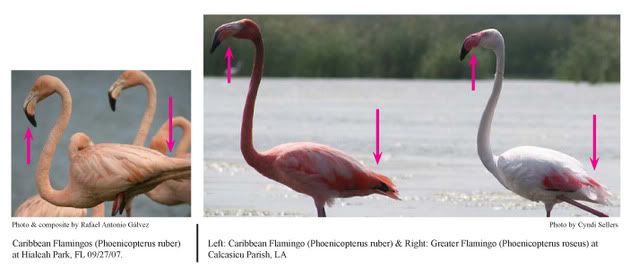
[ Follow Ups ] [ Post Followup ] [ TAS BirdBoard ] [ FAQ ]
Posted by Rafael Galvez on 23:49:31 10/05/07
In Reply to: Greater Flamingo color posted by Larry Manfredi

Excellent link Larry. We continue learning about flamingos.
Here I include a composite, including Hialeah flamingos on the left, and the photo taken by C. Sellers in Louisiana which features a Caribbean flamingo on the left and a Greater Flamingo (so-called Old World) on the right (from the link that Larry posted).
I wanted to point out that the wild flamingos seen at the Everglades (including the flock of 2002-03 with banded bird "DFJV", and the birds currently being sighted at Snake Bight and the bird seen this summer at Cutler Wetlands) all show bright coloration that contrasts markedly with the "free-flying" population at Hialeah Park.
Although the Hialeah Park birds featured here could be classified as "pink", their color is a mild rosy hue, or pale salmon; their plumage lacks primarily the bright scarlet flight-feathers and tertials typical of adult Caribbean Flamingos. Additionally, the birds at Snake Bight which could be classified as "immature" tend to have brighter-red plumage on their flight-feathers and heads, as do adults. This is completely untrue of the captive birds at Hialeah Park. Of the 350-or-so birds there, less than 10 birds had bright-scarlet coloration anywhere on their plumage. Interestingly, the 5 or six birds at Hialeah that did have some bright-scarlet plumage lacked the tell-tale scarlet tertials typical of wild flamingos. This is a revelatory feature of the captive Hialeah birds, possibly as a result of an altered diet.
Another feature to watch-out for in captive flamingos is the bill color. Nearly all the birds at Hialeah Park show very little bright-pink or red tones on their bills. Most of the birds sighted recently at Snake Bight (at close observation), show bright red coloration on the outer half of the lower mandible.
I thought this photo taken in Louisiana is particularly telling, and yet another reminder that the bird we have known as Greater Flamingo has been recently split into 2 species (this is widely accepted in Europe yet Americans seem to be late in recognizing), P. ruber in the Americas and P. roseus (Greater) in the Old World. Note the overall "white" appearance of the Greater Flamingo, the bright-pink flight-feathers yet the lack of bright-colored tertials, and the overall bright-pink bill; a very different bird indeed!
[ Follow Ups ] [ Post Followup ] [ TAS BirdBoard ] [ FAQ ]